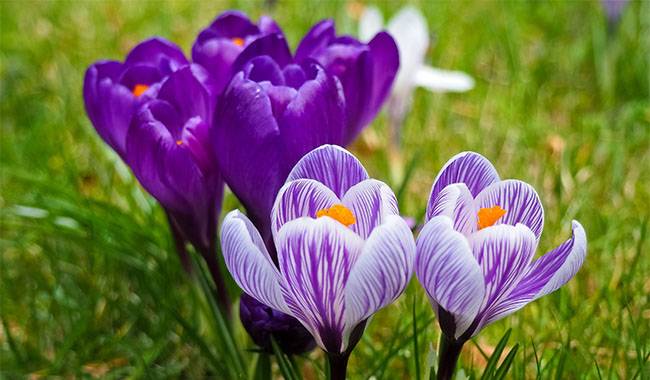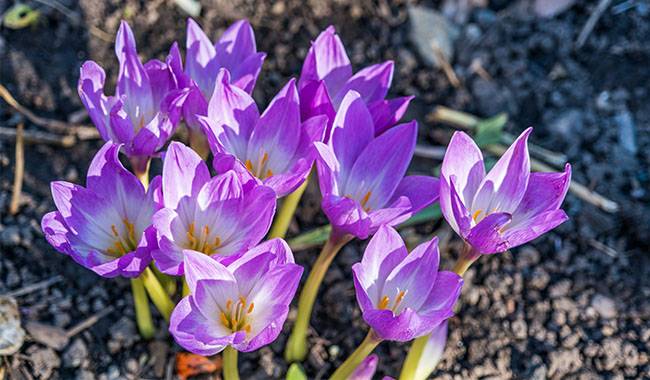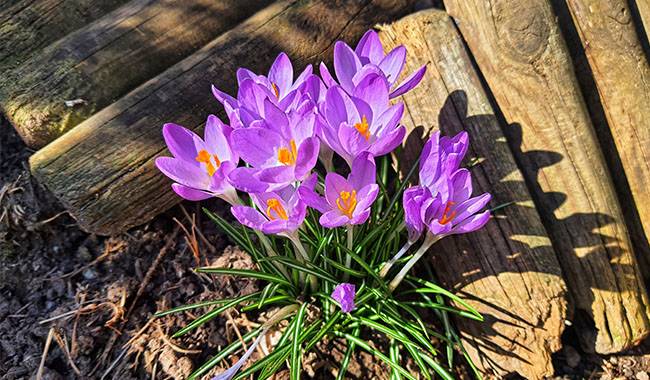
There is a scent of honey on the balcony, the sun is shining, and happy bees are fluttering on the delicate flowers. It feels like a miracle has happened, and spring has arrived unexpectedly! But the yellowing of the trees around us means late fall, which may be the last warm day of the year-I once discovered the autumn Crocus plant quite by accident. Since then, planting Crocus each year for fall blooms has become one of my favorite traditions. I’ll show you How to Care and Grow Crocus Flower at Home by a certain date in the fall in this ThumbGarden article.
HOW IS A FALL CROCUS DIFFERENT FROM A SPRING CROCUS?
When we talk about cut flowers, we usually refer to them blooming indoors in winter or early spring. The delicate, moving “live bunches” that finally sprout after a long winter rarely leave anyone indifferent and invariably fill their hearts with warmth. But Crocus in autumn is no slouch because the “first flowers” mysteriously appear when the garden is almost empty, the garden is long gone, spring has passed and the long winter is still ahead.
Pruning is an agricultural technique that results in plants that bloom at a time they don’t often do so. It is difficult to say whether fall-flowering Crocus is scientifically correct because in this case, we are talking about a special group of fall-flowering Crocus. nevertheless, using the techniques described in this article, it is possible to alter the flowering period of this crucifer so that it blooms before a certain fall month, or even delay the appearance of flowers until the New Year.
Most people associate Crocus with spring primroses. However, experienced florists are well aware that Crocus is divided into spring and fall flowers. The flowers of the former and the latter are similar in appearance: they are cup-shaped, with six delicate petals and a distinctive staminal column in the center of the flower.
The only difference is that spring Crocus open their flowers at the same time as their foliage. In contrast, almost all fall-flowering Crocus are leafless – a thread-like bunch of leaves appears in spring, does not flower, and withers in early summer, with only the flower, stems emerging from the ground in fall.
Spring-flowering Crocus are more common among gardeners because this group is more widespread, with a large number of varieties and hybrids for sale. However, an equally important reason why fall Crocus is less popular maybe the late blooming of this species.
The moving flowers of Crocus in the fall can only be enjoyed by those who live in private homes or by gardeners who live out of town year-round. However, the vast majority of flower lovers grow their plants in the countryside. Meanwhile, most gardeners move outside of town when Crocus blooms and stay outside less and less (some types and varieties even bloom in November). This means that, unfortunately, they often don’t get the chance to enjoy Crocus in full bloom.
In other years, when winter comes too early, Crocus don’t even have time to bloom and their buds fall under the snow. It is for this reason that once I bought my fall bulbs, I decided to organize a spring reciprocal so that they would bloom not in an empty garden, but in my city apartment.
AUTUMN CROCUS – SPECIALITY OF FLOWERING

I first bought planting material for Autumn Crocus a few years ago at the end of September. They are small bulbs with rather long white shoots, about 2 inches (5 cm) long.
I planted the bulbs fairly densely in 0.26 gals (1 liter) pots, 1 inch (2.5 cm) apart and 2 inches (5 cm) deep. I used soil from ready-made flowering plants. I did not add any additional fertilizer because the bulbs had already accumulated enough nutrients and were already sprouting.
Flowering occurs about 1.5-2 weeks after sowing. The total flowering period for fall crocuses is about two weeks, in mid to late October.
The weather at this time of year is relatively warm and there are no significant frosts, so I keep Crocus on my open balcony. They will close their flowers in the evening and open fully once the sun starts to shine on them. Since I was so impressed by the Crocus blooming on my balcony in mid-autumn, I decided to repeat the experience in the future.
As long as the temperature often dropped below 32 °F (0°C) at night, I watered the Crocus and put them in the vegetable compartment of the refrigerator. They stay there until spring (if you have a cellar, you can move the bulbs there).
In the spring, as soon as the snow melted, I fertilized with an all-mineral fertilizer and buried the pot with the bulbs in the garden, forgetting about them until the fall. in early September, I dug up the sleeping pot of Crocus, watered it well, and put it back in the fridge. There, the bulbs were kept until they were a few inches off the ground (sometimes Crocus don’t want to wake up in refrigerator conditions and must be brought to a warm place).
I moved the pots with the awakened bulbs to the balcony where they flowered about 1.5-2 weeks after they started active growth. On the outdoor balcony they were basically outdoors, so their flowering lasted quite a long time, just like outdoors – about two weeks.
Fall-flowering cocoons can also be placed indoors on a windowsill, but in this case, their flowering time will be shorter due to high temperatures and dry air.
To extend the total flowering time of Crocus, the bulbs can be planted in pots of different depths. This way, the deeper bulbs will bloom a little later and the lively bouquets will remain in bloom for a longer period. Also, if you are keeping Crocus indoors, you can bring them out onto an open balcony or keep them in the refrigerator to extend the blooming time, at least overnight.
Since Crocus in the refrigerator is slow to grow, you can push them back and adjust them to the desired date, or even delay them until winter. Most fall-flowering Crocus varieties can be easily bred in this way.
However, it sometimes happens that instead of “spouting” future flower stems, the bulbs grow leaves. In this case, Crocus will not bloom this season. The reason for this is not entirely clear, so for fall flowering, it is best to plant several pots to ensure that you have something to enjoy in the fall.
Experience has shown that Crocus seeds (Autumn Crocus) is the species most often affected. This species is also the least winter-tolerant of the fall-flowering Crocus grasses. For this reason, other species and cultivars are better suited for fall flowering and cultivation in the garden.
THE BEST FALL-FLOWERING CROCUS PLANT SPECIES

Crocus speciosus (Bieberstein’s crocus). It is the most fragrant of all fall-flowering Crocus and has a very pleasant honey scent. The flowers are star-shaped with pointed, snow-white petals, yellow anthers, and a bright orange column. The plant stands 6-8 inches (15-20 cm) tall. The flowers are about 1 inch (2.5 cm) in diameter.
Crocus pulchellus. The flowers are a delicate pale lilac color with darker shades of expressive veins. The center of the flower has yellow-orange anthers and a column. The flowers are cup-shaped with rounded edges. There is essentially no scent. Blooming flowers are about 2 inches (5 cm) in diameter. The height of the plant is 4-6 inches (10-15 cm).
Crocus kotschyanus / Crocus zonatus. The color of Crocus is a very unusual pinkish-purple. The stamens and column are bright oranges. The flowers are cup-shaped with slightly rounded petal tips. The flowers can be up to 2 inches (5 cm) in diameter when open. The flowers have a pleasant fragrance. The plant is 6 inches (15 cm) tall. Flowering time averages 10 days.
Crocus cancellatus. A fairly new species appeared on the market in 2017. The flowers of this species are very pretty bi-colored. The overall hue is a pale lavender with bright purple stripes and vein patterns on the outside of the petals. The center of the flower has bright yellow stamens and a column. The flowers are cup-shaped in appearance, with a cup height of about 2 inches (5 cm). The flower stems are 4-6 inches (10-15 cm) tall.







